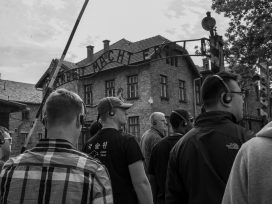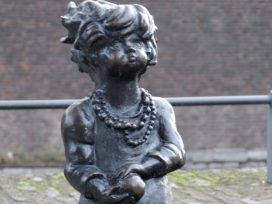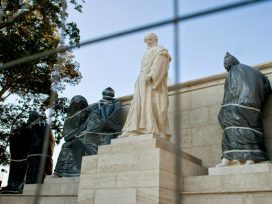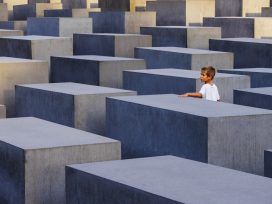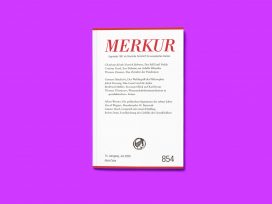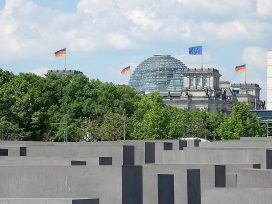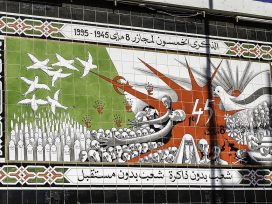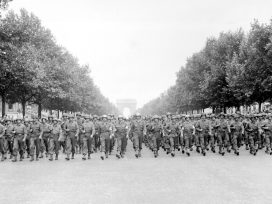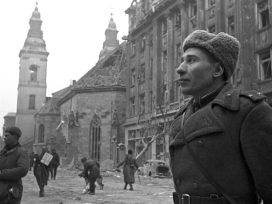The wrong kind of heroism
The Polish, Israeli and German heads of state came together for the first time ever to commemorate the 80th anniversary of Warsaw Ghetto uprising. Despite the international attention, great tensions lie under this political milestone, ranging from historical censorship to the claim to the moral high ground.
On the 80th anniversary of the Warsaw Ghetto Uprising, 19 April 2023, President Frank-Walter Steinmeier will be the first German head of state to speak in commemoration at the ‘Monument to the Heroes of the Ghetto’ in the Polish capital. This is an important site for the German culture of remembrance, as in 1970 German Chancellor Willy Brandt made the historic act of kneeling in front of this very monument as a gesture of apology and atonement. The ‘Kniefall von Warschau’ became one of the symbols of the new German Ostpolitik, which won the Chancellor the Nobel Peace Prize in 1971.
More than 50 years later, President Steinmeier has accepted the invitation of the President of Poland, Andrzej Duda to deliver a speech at the same place. Israeli President Isaac Herzog is also invited to attend the 2023 commemoration in Warsaw.
At first glance, the round anniversary of the Ghetto Uprising brings together three heads of state for the first time commemorating the Polish Jewish resistance together. However, behind the scenes lie fundamental differences in the memory of the Jewish struggle, the Holocaust and the legacy of the violent past within the societies of Poland, Germany and Israel.
Deciding how to die
The Ghetto Uprising was the armed resistance of Jews remaining in the Warsaw ghetto after the main German deportation action to the extermination camps (1942). Of the ghetto’s nearly half million inhabitants, only about 35,000–50,000 Jews had still avoided being rounded up at the Umschlagplatz and loaded onto wagons by 19 April 1943. To continue the extermination of the ghetto inhabitants, the Germans chose the Jewish holiday of Pesach. When they crossed the ghetto gate, the Jewish fighters opened fire. The insurgents had enough ammunition for a mere three days of armed resistance, after which the Germans began to systematically burn down all the district’s tenements with people hiding inside them, and hastily deport the remaining civilians to the death camps.
In this desperate confrontation, barely armed and starved civilian youths between the ages of 15 and 25 faced a heavily equipped regular German army, equipped with flamethrowers and tanks. Yet the ruthless liquidator Jürgen Stroop announced the final ‘pacification’ of the ghetto only on May 16.
In this tragic and unequal struggle, Jews lost their lives trying to take as much a revenge as they could. The wounded were burned alive by the Germans. The 24-year-old commander of the uprising Mordechai Anielewicz, along with a group of 120 fighters were killed when the Germans blew up their bunker. It is possible, however that the group had committed collective suicide earlier. A few dozen fighters managed to leave the ghetto after traversing of the city’s sewers for two whole days.
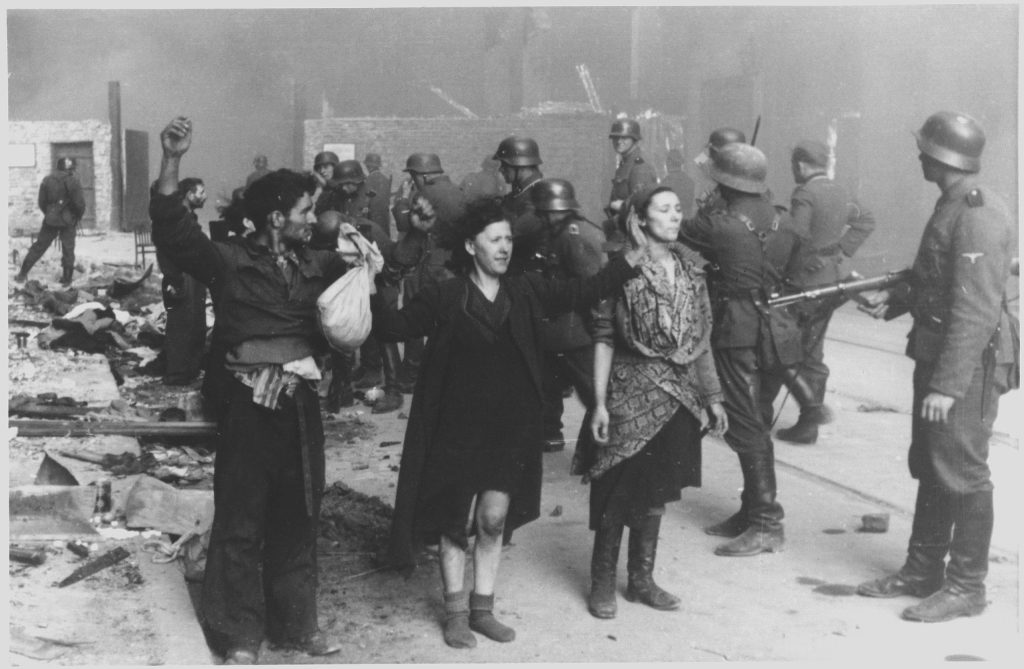
Resistance members captured at Nowolipie 64 near intersection with Smocza. Taken between 19 April 1943 and 16 May 1943 by an unknown photographer. Source: Wikimedia Commons.
A makeshift salvation story
More than 170 events are planned throughout the 80th anniversary year in Poland alone, nearly a hundred of those around April and May, marking great public interest in this occasion.
But how is the Jewish struggle commemorated in Poland today? What lessons can be drawn from it and what do the ghetto insurgents stand for? The answers to these questions reveal a clear division between official state commemorations and remembrance initiatives rooted in civil society.
Soon after 2015, when the political Right took power in Poland, it began its conquest of the past. The ruling Law and Justice Party (PiS) took control of cultural institutions, single-handedly appointing directors of the relevant institutions, including the Museum of the History of Polish Jews POLIN.
The result is a far-reaching monopolization of the historical narrative regarding the Second World War and the Holocaust, streamlined with a rightwing vision, whose main ‘historical’ concern in recent years has been to deny any form of Polish complicity in the Holocaust. It has got as far as attempting to criminalize even the ‘insinuations’ of any such responsibility. Instead of critical reflection on violence, this Polish government narrative is fully in line with the so-called rescue turn in Holocaust memory, focusing on uplifting histories of assistance, distorting the image of the past.1
Since this policy stifles independent and critical research on the Holocaust on Polish soil, many Polish Holocaust researchers, and the wider the cultural community, including the descendants of survivors, are publicly declining invitations to official memorial ceremonies of the Ghetto Uprising. Monika Sznajderman is the daughter of the only survivor in her family, and author of the poignant family-biographical book Pepper Counterfeiters.2 She refers to the presidential invitation as a slap in her face:
I distance myself as far as possible from nationalist politicians, for whom human suffering and the Holocaust are cynical political games, and the Jews themselves are reduced to objects of the heroic actions of Polish society, whose noble goal was to save as many of them as possible.
Sznajderman herself will commemorate the uprising in a different way: as the editor of a book published to mark the anniversary, which deals with women fighters in the ghetto, and the gendered aspect of struggle and resistance.3
The independent research on the attitudes of Christian Poles toward Jews during World War II, which are so upsetting to the Polish government, draw a rather pessimistic picture: assistance was the ultimate but rare heroism, indifference prevailed, and there was no shortage of denunciations and participation in murders. Also, military aid to the Jewish Ghetto Uprising, despite repeated fervent pleas from the insurgents to the Polish underground, was scarce.
Today, however, the politicians and cultural nomenclature of PiS include the Ghetto Uprising in the tradition of heroic Polish independence struggles, without a shadow of critical reflection. It is stressed as the first urban uprising in German-occupied Europe, and was followed by the by far largest such act of European resistance against the Nazis: the Warsaw Uprising in 1944 (August-October).
Far from unified
The top-down political agenda now appropriates the memory of the Jewish insurgents causing protest in Poland, but the Ghetto Uprising was a sphere of heated debate also earlier , and mainly among its active participants: those who, after the war, built on its legend in Israel as resistance fighters (‘the Masada of Warsaw’) and those who remained in Poland and inscribed the uprising in a typically Polish act of resistance, devoid of much hope of winning.
In Israel, perceptions of the uprising have gone through various phases of internal dispute. In these, former insurgents often emphasized the expression mitat kavod, death with honour. Initially, the legend of the uprising was used to counter the perception of ‘passive’ Eastern European Jews as the opposite of the strong sabra, those born in the land of Israel. Later, it became an important element in boosting the morale of the fighters in Arab-Israeli wars.
Among those who stayed in Poland, Marek Edelman, the last surviving leader of the Warsaw Ghetto Uprising, was a central figure. Since Hanna Krall published a book-length interview with Edelman (1976 4), his blunt and impatient message has caused resonance:
there was nothing heroic in our struggle.
He considered retrospective pathos empty, if not phony. He kept repeating:
Could this even be called an uprising? It was about not getting butchered when it was our turn and the Germans came after us. It was just about choosing how to die.
Kazik Ratajzer phrased it this way:
I did not and do not say that the uprising was for history, for the nation, for honour. I simply did not want to suffocate in a gas chamber. So it was easier to die fighting. It was quicker.
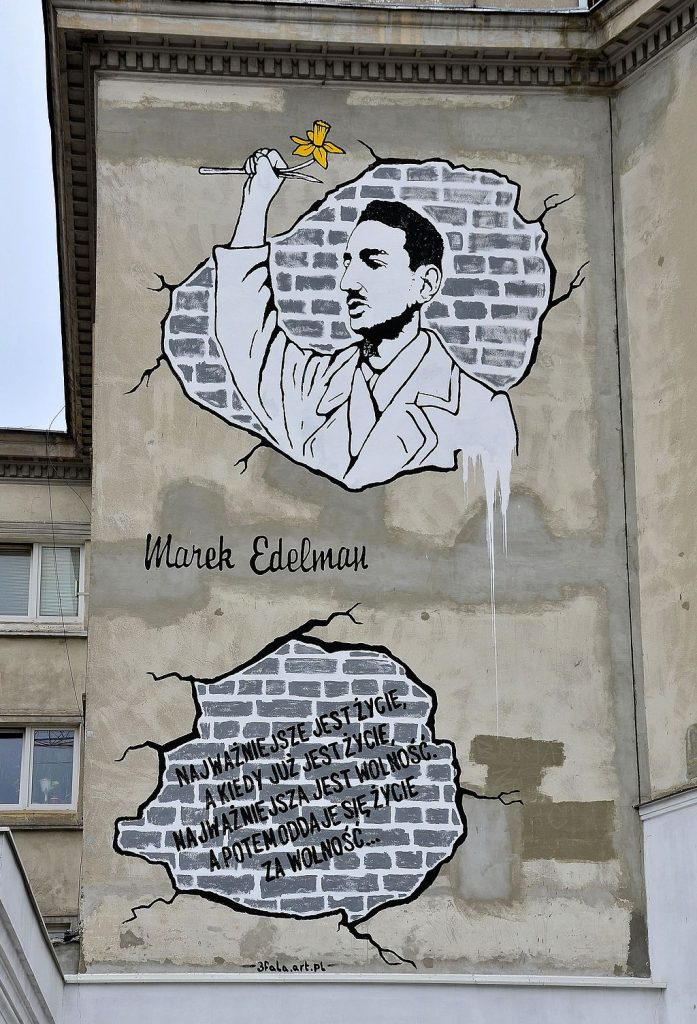
Mural in memory of Marek Edelman at 9b Nowolipki Street in Warsaw. Adrian Grycuk via Wikimedia Commons.
The 1943 resistance has many interpretations, and the divisions do not run necessarily by state, but cut across societies, both in Israel and Poland. A case in point is the new Warsaw Ghetto Museum, planned to be opened in a near future. Critics of the Polish government fear an exhibition embedded in the pervasive narrative of Polish heroism and ‘Polish-Jewish camaraderie’. The museum already engenders both support and controversy in both countries.
In Poland, the initiative is sometimes seen as a competition for the popular Museum POLIN. The Polish Ministry of Culture and National Heritage appointed two leaders responsible for the shape of the future institution: one Polish (director) and one Israeli (chief historian). Since then, Prof. Daniel Blatman of the Hebrew University of Jerusalem has been criticized by many Israeli Holocaust scholars for agreeing to potentially legitimize the distorted Polish right-wing narrative of Jewish-Christian fraternity during the war.
This new cooperation takes place among the many challenges that Polish politicians have recently posed to their Israeli counterparts. They include the already mentioned attempts at silencing historians about the complicity of Christian Poles in the murder of their Jewish fellow citizens, as well as the issue of traditional Israeli schoolchildren’s tour programs, which the Polish government has decided to censor.5
And this issue is at the heart of the division in Israel. In order to cooperate with official Polish institutions, one has to tolerate their narrative of past friendship and emphasise the role of the Polish Righteous. It doesn’t allow for reflecting on the indifference, or even the outright antisemitism of the Christian neighbors who are acutely remembered by Israeli families of Polish roots.
The Polish ruling circles are also very assertive toward Germany, emphasizing reparations for the damages of World War II.
Underhanded moral highground
And yet, the German president is the most conciliatory party at the anniversary of the Ghetto Uprising.
Contrary to Poland and Israel, the German memorialization of the uprising is the least uncontested and well-ritualised. Germany has long acknowledged its role as the perpetrator and has created a strong culture of remembrance around its own unquestioned culpability. The anniversary of the Ghetto Uprising has therefore not caused any controversy in the German public sphere, but no significant interest either.
The German public sphere, however, has been shaken for the past two years or so by a larger controversy surrounding the culture of Holocaust remembrance as a whole, in the context of colonial genocide. As the historian Dirk Moses suggested, the German public discourse has made Holocaust remembrance and the uniqueness of this crime a point of their national catechetical faith, which negates migrant perspectives from the Global South on racially-based discrimination and violence in a colonial context.
This critical view of German memory culture is now part of a broader debate about the colonial roots and common elements of genocidal violence (Jürgen Zimmerer, Michael Rothberg), which, however, are met with much resistance in Germany, fearing a potential relativization of the Holocaust. By officially acknowledging guilt towards the Jews and building a robust culture of Holocaust remembrance, Germany became a model globally praised ‘having come to terms with its own past’ and has gained a certain moral superiority (or leadership) over those nations who hesitate to do so.
In the context of the upcoming commemorations of the Ghetto Uprising in Warsaw, the German position has ambiguous implications. The country’s plea for the uniqueness of the Holocaust is certainly approved by the participating Israeli state officials. Yet, the moral virtue signaling on the occasion of remembering the murder of tens of thousands of people by German hands makes President Steinmeier’s participation in the Warsaw celebrations a delicate mission.
The wrong kind of heroism
Despite these differences and the fallacies of memory politics, these three heads of state will come together in Warsaw. We’re yet to see whether their official speeches will reverberate that it was in a deep sense wrong heroism that we are celebrating.
This heroism did not stand a chance. Placing the uprising comfortably in the ranks of heroic struggle qualifies as memorial cynicism. No amount of Jewish heroism could have changed or stopped the Germans, who continued to treat the insurgents not as combatants or soldiers, but as subhuman. The Polish underground did not properly support their Jewish comrades.
What can help challenge superficial and politicized narratives and overcome what is wrong with the heroic interpretation of the uprising is to listen carefully to the last survivors and their testimonies, and carefully tend to the archives, those consolidated and the sources still dispersed.
If there is one lesson we can take from this is that the insurgents exemplified total isolation of the Jews in wartime Poland, and all over Europe.
On the sunny days of April 1943, there were carousels running outside the wall of the burning ghetto, where Polish Catholic children played while their Jewish peers were being burnt alive. Today, politicized commemorations use the memory of the uprising to signal a moral position. As much as this is predictable, one can still hope that the essence of the Ghetto Insurgents wouldn’t be lost: those young people could only choose how they would die, not whether they would die. Perhaps it was also about mitat kavod, death with honour, after all.
This article is an updated version of the original written for the Italian journal MicroMega.
Conf. The Rescue Turn and the Politics of Holocaust Memory, eds. Natalia Aleksiun, Raphael Utz, and Zofia Wóycicka, Wayne State Univ. Press 2023.
Monika Sznajderman, Fałszerze pieprzu. Historia rodzinna, Czarne 2016. Quotes translated by Lidia Zessin-Jurek.
Kwestia charakteru. Bojowniczki z getta warszawskiego, eds. Sylwia Chutnik, Monika Sznajderman, Czarne 2023.
Hanna Krall, Zdążyć przed Panem Bogiem (Eng.: The Subtenant; To Outwit God, Northwestern University Press 1992).
Israel's Lapid: Holocaust School Trips Nixed Over Poland's Demand to Sway Narrative In Haaretz 15 June 2022.
Poland dispute over Holocaust school trips’content resolved, says outgoing minister In Times of Israel 1 January 2023.
Published 17 April 2023
Original in English
First published by MicroMega
© Lidia Zessin-Jurek / MicroMega / Eurozine
PDF/PRINTNewsletter
Subscribe to know what’s worth thinking about.
Related Articles
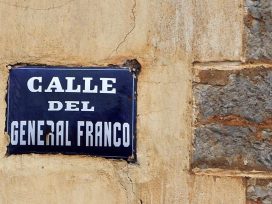
Controversies over the legacies of dictatorship and civil war have polarized the Spanish debate for over two decades. Now, on the fiftieth anniversary of Franco’s death, the legitimacy of the transition is uncertain. Could things have been done differently?
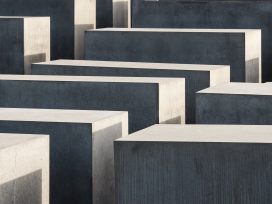
Provocative far-right calls for Germany to ‘move on’ from historical guilt miss the point: politics of memory and its practices may transition from contrition to responsible forgetting, but there is no end date to remembering that should accommodate diverse members of society.
